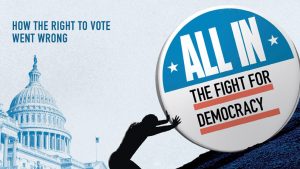Voter suppression has been a factor in our nation’s elections for as long as there’s been an America. “All In: The Fight For Democracy” is a documentary that traces that history.
Its central figure is Stacey Abrams, a Democrat who ran for governor of Georgia in 2018 against Republican Brian Kemp who, at the time, was the incumbent Secretary of State of Georgia and thus the man in charge of the election. That’s a clear conflict of interest, for a candidate in the race to also be in charge of it. Of course, he won, thanks to many of the precincts (where Abrams was favored) not getting enough voting machines that functioned correctly and many Democrats being purged from the rolls. On top of that, Kemp consolidated precincts, forcing voters in those areas to travel much further than in his supporters’ districts.
Since then, Abrams has become an advocate for ensuring that any American who wants to vote can do so without hardship. It’s a battle that’s still being fought in too many states and municipalities in this election year, exacerbated by concerns over mail-in voting and getting enough poll workers during a pandemic.
“All In” directors Lisa Cortés and Liz Garbus take viewers through the timeline of voter suppression, from the era of women’s suffrage to poll taxes and literacy tests in the Jim Crow south to the marches in Selma. It also covers the Voting Rights Act that President Johnson signed in 1965, which was reaffirmed under Republican presidents (Ford, Reagan, Bush 41, and Bush 43), until it was undone by the Supreme Court in 2013 in the case of Shelby County v. Holder. That decision was led by Chief Justice John Roberts, whose mentor had been his predecessor William Rehnquist, who, before sitting on the highest bench in the land, had spent several years in Arizona successfully keeping non-whites from voting.
It wasn’t until the Trump era that the notion of voter fraud swinging an election became a widespread conspiracy theory on the right — despite Trump’s own investigative commission on election integrity finding no evidence to support his claims. Instead of issuing a report saying so, the commission was disbanded without making its conclusions public, and he and his acolytes continue to lie about it.
To watch “All In” is to learn the pattern — of intentional underfunding of elections, malfunctioning machines, and gerrymandering — that is a scourge keeping far too many people (mostly of color) from exercising their constitutional right to vote, the very foundation of democracy. Thus, it serves as not just a flashback, but also as a foreshadowing of what to expect on Election Day, November 3.
It should be required viewing for every high school American history class. Unfortunately, in too many states whose statehouses are deeply red, that will never happen — for the same reason virtually no Republicans will watch this movie.
Calling the movie “All In” will make some people believe it’s about poker. They should have opted for “The Fight For Democracy” instead. Still, I give it a 9 out of 10.
It begins streaming on Prime Video today.

